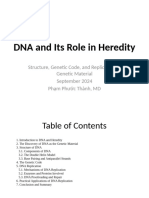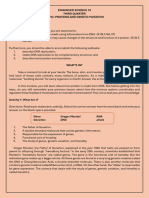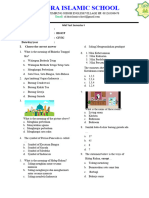0 ratings0% found this document useful (0 votes)
27 viewsActivity 4
Activity 4
Uploaded by
R Jay LagdaminDNA is the blueprint of life found in the nucleus of cells. It has a double helix structure with a sugar-phosphate backbone and nitrogen bases bonding between strands. DNA contains genes that code for traits and is replicated for cell division. When DNA is replicated, the double helix unwinds and each strand acts as a template to make a new complementary strand.
Copyright:
© All Rights Reserved
Available Formats
Download as DOCX, PDF, TXT or read online from Scribd
Activity 4
Activity 4
Uploaded by
R Jay Lagdamin0 ratings0% found this document useful (0 votes)
27 views6 pagesDNA is the blueprint of life found in the nucleus of cells. It has a double helix structure with a sugar-phosphate backbone and nitrogen bases bonding between strands. DNA contains genes that code for traits and is replicated for cell division. When DNA is replicated, the double helix unwinds and each strand acts as a template to make a new complementary strand.
Original Title
Activity_4
Copyright
© © All Rights Reserved
Available Formats
DOCX, PDF, TXT or read online from Scribd
Share this document
Did you find this document useful?
Is this content inappropriate?
DNA is the blueprint of life found in the nucleus of cells. It has a double helix structure with a sugar-phosphate backbone and nitrogen bases bonding between strands. DNA contains genes that code for traits and is replicated for cell division. When DNA is replicated, the double helix unwinds and each strand acts as a template to make a new complementary strand.
Copyright:
© All Rights Reserved
Available Formats
Download as DOCX, PDF, TXT or read online from Scribd
Download as docx, pdf, or txt
0 ratings0% found this document useful (0 votes)
27 views6 pagesActivity 4
Activity 4
Uploaded by
R Jay LagdaminDNA is the blueprint of life found in the nucleus of cells. It has a double helix structure with a sugar-phosphate backbone and nitrogen bases bonding between strands. DNA contains genes that code for traits and is replicated for cell division. When DNA is replicated, the double helix unwinds and each strand acts as a template to make a new complementary strand.
Copyright:
© All Rights Reserved
Available Formats
Download as DOCX, PDF, TXT or read online from Scribd
Download as docx, pdf, or txt
You are on page 1of 6
Name: Score:
Course & Section: Date:
Activity #4: What is DNA?
Objectives:
At the end of this activity, students will be able to
a. describe the structure of DNA, and
b. explain the significance of DNA replication.
Key terms: Deoxyribonucleic acid (DNA), Nucleotide, double helix, adenine, thymine, cytosine,
guanine, genetics, gene, chromosomes, replication, Mitosis Meiosis
Introduction:
The nucleus is a small spherical, dense body in a cell. It is called the “control center”
because it controls all the activities of all cell. Chromosomes, found in the nucleus, are
microscopic, threadlike strands composed of the chemical DNA (short for deoxyribonucleic
acid).
Chromosomes are composed of genes, which is a segment of DNA that codes for a
particular protein which in turn codes for a trait. It is commonly referred to as the gene for
baldness or the gene for blue eyes.
In the 1953, James Watson and Francis Crick established the structure of DNA. The
shape of DNA is a double helix, which is like a twisted ladder. The sides of the ladder are made
of alternating sugar and phosphate molecules. The sugar is deoxyribose. Color all the phosphates
red (labeled with a “p”). Color all the deoxyribose blue (labeled with a “D”).
The rungs of the ladder are pairs of 4 types of nitrogen bases. The bases are known by
their coded letters A, G, T, C. These bases always bond in a certain way. Adenine will only bond
to thymine. Guanine will only bond with cytosine. The bases can occur in any order along a
strand of DNA. The order of these bases is the code that contains the instructions. For instance
ATGCGCATAT would code for a different gene than CGATCGCGAT. A strand of DNA
contains millions of bases.
Color the thymine’s
orange
Color the adenines green
Color the guanines
purple
Color the cytosine
yellow
The Blueprint of Life
Every cell in your body has the same “blueprint” or the same DNA. Like the blueprints of
a house tell the builders how to construct a house, the DNA “blueprint” tells the cell how to build
the organism. Yet, how can a heart be so different from a brain if all the cells contain the same
instructions? Although much work remains in genetics, it has become apparent that a cell has the
ability to turn off most genes and only work with the genes necessary to do a job. The DNA
apparently is nonsense and codes for nothing. These regions of DNA that do not code for
proteins are called “introns”, or sometimes “junk DNA”. The sections of DNA that do actually
code from proteins are called “exons”.
INSTRUCTIONS: Color the images.
DNA—the Double Helix
All living things which contains
I. What is DNA?
Stands for:
Functions: 1.
2.
3.
4.
5.
II. Scientists discovers the DNA
III. Structure of DNA
Shape
Side Pieces 1.
2.
Steps in the Ladder Name:
a.
b.
c.
d.
How do the nitrogen bases fit together?
A-T contains C-G Contains
The Three Part Name:
Unit
Held Together By: One Complete Turn is
Drawing
IV. Where is DNA located?
Chromosomes Draw an image of what chromosomes look
like:
Chromosomes and complexity:
# of chromosomes in BODY CELLS (humans) # of chromosomes in SEX CELLS
(humans)
Male chromosomes arrangement:
Female Chromosomes arrangement:
Genes Drawing Example
Traits Drawing/Example
V. Making Copies of DNA
Purpose
1.
Process of
2.
Replicatuion
3.
4.
Definition Possible causes of mutations
Mutation
Examples of mutations:
You might also like
- CRANE GRAHAM Beehives From Ancient GreeceDocument13 pagesCRANE GRAHAM Beehives From Ancient GreeceCharlotte FrmxNo ratings yet
- DNA StructureDocument4 pagesDNA StructureMaybella PruntyNo ratings yet
- Solution Manual Thermodynamics Sanford KleinDocument65 pagesSolution Manual Thermodynamics Sanford KleinMonica estefania Leal bossaNo ratings yet
- A Detailed Lesson Plan in Science 10: Panpacific University Urdaneta City, Pangasinan School of Basic EducationDocument5 pagesA Detailed Lesson Plan in Science 10: Panpacific University Urdaneta City, Pangasinan School of Basic EducationGomez Agustin Leslie100% (1)
- Science: Modified Strategic Intervention MaterialsDocument28 pagesScience: Modified Strategic Intervention MaterialsSanJoseHS100% (2)
- Muslim-Christian Polemic During The Crusades The Letter From The People of Cyprus and Ibn Abi Talib Al-Dimashqi's Response PDFDocument525 pagesMuslim-Christian Polemic During The Crusades The Letter From The People of Cyprus and Ibn Abi Talib Al-Dimashqi's Response PDFHiroNo ratings yet
- Lesson-Guide 2module - G9-Biology Module 2 On Template PDFDocument31 pagesLesson-Guide 2module - G9-Biology Module 2 On Template PDFconstancia G, caraan100% (1)
- Lesson-Guide 2module - G9-Biology Module 2 On TemplateDocument31 pagesLesson-Guide 2module - G9-Biology Module 2 On Templateconstancia G, caraanNo ratings yet
- Learning Activity Sheet Science 9 Quarter 1 Week 3Document11 pagesLearning Activity Sheet Science 9 Quarter 1 Week 3Mabell Mingoy100% (1)
- A Sjfhlkaj HSFDocument9 pagesA Sjfhlkaj HSFxinyi.huang3No ratings yet
- Dna StructureDocument32 pagesDna StructureHONLETH ROMBLONNo ratings yet
- Annotated-Kami Export - DNA WorksheetDocument6 pagesAnnotated-Kami Export - DNA WorksheetFredrick DanielsNo ratings yet
- DNA ReplicationDocument5 pagesDNA ReplicationfletcherplayscriptsNo ratings yet
- The Story of DNA - Script and Answer KeyDocument3 pagesThe Story of DNA - Script and Answer KeyAdam SimpsonNo ratings yet
- DNA Structure by NeerajDocument21 pagesDNA Structure by NeerajNeeraj BahugunaNo ratings yet
- Science 10 - Q3 - Week 4Document22 pagesScience 10 - Q3 - Week 4kimberly.tanoNo ratings yet
- What Is DNADocument22 pagesWhat Is DNASehar AslamNo ratings yet
- Science10 Q3 Week4Document22 pagesScience10 Q3 Week4Samad Recca T. NatividadNo ratings yet
- Orca Share Media1662355444548 6972424090491517852Document9 pagesOrca Share Media1662355444548 6972424090491517852Mic Houston Mar T. Parro100% (1)
- Biology Today and Tomorrow without Physiology 5th Edition Starr Solutions Manual all chapter instant downloadDocument43 pagesBiology Today and Tomorrow without Physiology 5th Edition Starr Solutions Manual all chapter instant downloadkliknamsakwa100% (4)
- DNA QuizDocument2 pagesDNA QuizElcid BocacaoNo ratings yet
- DNA Structure and ReplicationDocument5 pagesDNA Structure and ReplicationLindsey BoardmanNo ratings yet
- 1934 FdocDocument6 pages1934 Fdoctyleryawh2072No ratings yet
- Day 3Document8 pagesDay 3Kinberly AnnNo ratings yet
- Life Sciences Gr.12 Term 1 Weeks 1-3 DNA & Protein SynthesisDocument45 pagesLife Sciences Gr.12 Term 1 Weeks 1-3 DNA & Protein Synthesis22sv5111No ratings yet
- Biodiversity - DNA - The Double HelixDocument3 pagesBiodiversity - DNA - The Double HelixAkram NiaziNo ratings yet
- Chromosomes Genes and DNA (2)Document17 pagesChromosomes Genes and DNA (2)zachandreasabustanNo ratings yet
- Q1 Sci9 Mod6Document18 pagesQ1 Sci9 Mod6Regine Rafer Escalante100% (2)
- Life Sciences Grade 12 Survival Kit Paper 2Document35 pagesLife Sciences Grade 12 Survival Kit Paper 2Masentle MonicaNo ratings yet
- Dna-Structure ActivityDocument3 pagesDna-Structure Activityalindoganchristina85No ratings yet
- DNA, Chromosomes, and Genomes-66587207Document43 pagesDNA, Chromosomes, and Genomes-66587207Abdo HusseinNo ratings yet
- Topic 3 DNA - and - HeredityDocument26 pagesTopic 3 DNA - and - HeredityThanh PhamNo ratings yet
- Grade-10-LAS-Week-4A-3rd - QuarterDocument5 pagesGrade-10-LAS-Week-4A-3rd - QuarterYaRNo ratings yet
- D 2.2 - ExercisesDocument9 pagesD 2.2 - Exercisesalexandra25No ratings yet
- The Genetic Material-1Document48 pagesThe Genetic Material-1Windra TrivenNo ratings yet
- CB3b DNADocument22 pagesCB3b DNAMysticalNo ratings yet
- Omar - BuildingDNASEDocument4 pagesOmar - BuildingDNASEOMAR ID-AGRAMNo ratings yet
- DNA and RNA Structure NotesDocument4 pagesDNA and RNA Structure NotesShawnNo ratings yet
- Building DNA SEDocument4 pagesBuilding DNA SERicky DunlapNo ratings yet
- DNA, Genes and ChromosomesDocument36 pagesDNA, Genes and Chromosomeshenel tallerNo ratings yet
- Immediate download Genetics Analysis and Principles 5th Edition Brooker Solutions Manual all chaptersDocument40 pagesImmediate download Genetics Analysis and Principles 5th Edition Brooker Solutions Manual all chaptersgiscatoune100% (1)
- The Molecular Basis of InheritanceDocument40 pagesThe Molecular Basis of InheritanceMarcus Robinson100% (1)
- q3 DNA RNADocument22 pagesq3 DNA RNADante tuminesNo ratings yet
- Chapter 3: DNA and The Genetic CodeDocument30 pagesChapter 3: DNA and The Genetic CodeRubén De Gracia SantoNo ratings yet
- DNA StructureDocument4 pagesDNA StructureMG - 11CJ 972501 Cawthra Park SSNo ratings yet
- SBI4U Assignmentfor Unit 3 Mini Summative Chapter 6 YuchucaoDocument5 pagesSBI4U Assignmentfor Unit 3 Mini Summative Chapter 6 Yuchucaoyao fengNo ratings yet
- Unit 4 11Document110 pagesUnit 4 11Gabi TuriNo ratings yet
- Lesson-3 Protein-Synthesis WorksheetDocument10 pagesLesson-3 Protein-Synthesis WorksheetEnriquez, Hannah Roniella R.No ratings yet
- Selina Concise Biology Class 10 Solutions Chapter 2Document21 pagesSelina Concise Biology Class 10 Solutions Chapter 2Sandipan BhuinaNo ratings yet
- HW 3B 17 JanDocument3 pagesHW 3B 17 Janishanth093No ratings yet
- CH 12 DNA Genetic Material PDFDocument93 pagesCH 12 DNA Genetic Material PDFasaNo ratings yet
- Dna Rna 11Document70 pagesDna Rna 11L CuevasNo ratings yet
- Virtual Lab-BuildingDNASEDocument5 pagesVirtual Lab-BuildingDNASEsmol ukeleleNo ratings yet
- Dna Introduction 8753Document11 pagesDna Introduction 8753shilpa SNo ratings yet
- Biology Notes Short Alll CLASS 10Document34 pagesBiology Notes Short Alll CLASS 10thanosnaidu7No ratings yet
- Science 10 q3 Week 4 Lessons 8-11Document33 pagesScience 10 q3 Week 4 Lessons 8-11JennyFloresNicolas100% (2)
- DNA Review Worksheet: GatccatgagttacDocument1 pageDNA Review Worksheet: GatccatgagttacMarcela Ríos FloresNo ratings yet
- LXL - Gr12LifeSciences - 01 - DNA - The Code of Life - 05feb2014Document5 pagesLXL - Gr12LifeSciences - 01 - DNA - The Code of Life - 05feb2014Linda BurgNo ratings yet
- Study Guide BiologyDocument8 pagesStudy Guide BiologyBayron SaucedaNo ratings yet
- Lecture 1-Genetic Material, DNA Structure and Replication-2Document46 pagesLecture 1-Genetic Material, DNA Structure and Replication-2UJPNo ratings yet
- ABR2 VL Fall2019Document35 pagesABR2 VL Fall2019wm6g42452bNo ratings yet
- WPH06 01 Que 20190128daDocument20 pagesWPH06 01 Que 20190128daHamza Tahir IqbalNo ratings yet
- Solution Focused TherapyDocument13 pagesSolution Focused TherapyKen Murray100% (1)
- Dead To Me S01e02Document38 pagesDead To Me S01e02SpeedyGonsalesNo ratings yet
- Xenophon PresentationDocument27 pagesXenophon PresentationAí NguyễnNo ratings yet
- Resume TemplateDocument2 pagesResume Templateapi-407859718No ratings yet
- Congenital Syphilis Treatment and PreventionDocument1 pageCongenital Syphilis Treatment and PreventionMuhammad Naufal FadhillahNo ratings yet
- Abba 98 Realty. Your Property Manager For Condominium Units in The Philippines.Document44 pagesAbba 98 Realty. Your Property Manager For Condominium Units in The Philippines.Abba0% (1)
- At The AirportDocument2 pagesAt The Airportlakmus6No ratings yet
- Interview Mahendra K. MishraDocument6 pagesInterview Mahendra K. MishraVasudev MurthyNo ratings yet
- Initial Redacted Incident ReportDocument4 pagesInitial Redacted Incident Reportmaggie.brownNo ratings yet
- Nokia Information SystemDocument3 pagesNokia Information SystemRia Singh67% (3)
- The Wars of The RosesDocument15 pagesThe Wars of The RosesLatreche KamilyaNo ratings yet
- Food Hygiene Standards in SingaporeDocument6 pagesFood Hygiene Standards in SingaporeAndreas OctavianoNo ratings yet
- Uranium Deposits of PakistanDocument5 pagesUranium Deposits of PakistanMuhammad RizwanNo ratings yet
- Civic Grade 3Document3 pagesCivic Grade 3ketemu AnharNo ratings yet
- Test Đầu Vào ToeicDocument4 pagesTest Đầu Vào ToeicNhat Tran100% (1)
- Cases - To DigestDocument358 pagesCases - To DigestApril Charm ObialNo ratings yet
- XRC Controller PMT Fuction ManualDocument28 pagesXRC Controller PMT Fuction ManualsunhuynhNo ratings yet
- Syllabus5 LLM-SV UniversityDocument26 pagesSyllabus5 LLM-SV Universityhide123456789No ratings yet
- OSI Network Layer: CCNA Exploration Semester 1 - Chapter 5Document35 pagesOSI Network Layer: CCNA Exploration Semester 1 - Chapter 5Vijaya PriyaNo ratings yet
- Thole CompanyProfileDocument8 pagesThole CompanyProfileThabo KhuluseNo ratings yet
- Action Research Proposal PreliminaryDocument23 pagesAction Research Proposal PreliminaryJENEVIE SALIOTNo ratings yet
- Proposal For Christmas RaffleDocument3 pagesProposal For Christmas RafflePresy PandoroNo ratings yet
- Re: Christina Depamphilis vs. Paul Maravelias Docket No. 473-2016-Cv-00124Document25 pagesRe: Christina Depamphilis vs. Paul Maravelias Docket No. 473-2016-Cv-00124Paul MaraveliasNo ratings yet
- Lecture 04-Seismic Provisions Based On NSCPDocument35 pagesLecture 04-Seismic Provisions Based On NSCPRA CruzNo ratings yet
- A Reflection of The Life Changing Experience in My LifeDocument2 pagesA Reflection of The Life Changing Experience in My LifeEricka Rivera SantosNo ratings yet
- First Steps With Palo For ExcelDocument104 pagesFirst Steps With Palo For ExcelDavid AcuñaNo ratings yet

























































































